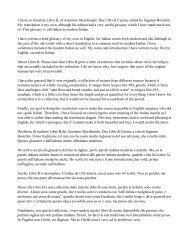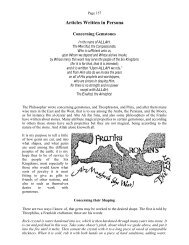How to Milk an Almond Stuff an Egg And Armor a Turnip A ...
How to Milk an Almond Stuff an Egg And Armor a Turnip A ...
How to Milk an Almond Stuff an Egg And Armor a Turnip A ...
Create successful ePaper yourself
Turn your PDF publications into a flip-book with our unique Google optimized e-Paper software.
158<br />
A Dinner at Pennsic<br />
My lord <strong>an</strong>d I have the cus<strong>to</strong>m of cooking dinner for our entire encampment one evening at<br />
Pennsic, working from period recipes. On this occasion we were cooking for 25 people. Our<br />
constraints are that there are only two of us, although we usually get some help; we have a fairly<br />
good kitchen set-up, but it does not so far include <strong>an</strong> oven; we do not keep a cooler at Pennsic;<br />
<strong>an</strong>d we w<strong>an</strong>ted <strong>to</strong> do something simple enough that we could be assured of being able <strong>to</strong> wash the<br />
dishes in daylight.<br />
The easiest sorts of food <strong>to</strong> cook over a campfire are spit-roasted meat <strong>an</strong>d dishes in a large<br />
pot or frying p<strong>an</strong>. As no one in our camp was making a grocery s<strong>to</strong>re run that day, we decided<br />
against meat. Greens, eggs, <strong>an</strong>d butter were the most perishable foodstuffs we were using, <strong>an</strong>d all<br />
will keep for a day or two without refrigeration as long as you do not leave them out in the sun;<br />
also, eggs are available on site. As we make them, two of the recipes have meat broth. They<br />
could, however, be made suitable for a medieval fast day out of Lent (or for a modern vegetari<strong>an</strong>)<br />
by using vegetable broth instead, as the original recipes merely say “good broth.” I figured that <strong>to</strong><br />
feed that number of people we would probably need three large pots of food, so we might as well<br />
make three different dishes as well as dessert.<br />
There are several medieval versions of noodles <strong>an</strong>d cheese, both English <strong>an</strong>d Itali<strong>an</strong>. We chose<br />
Losyns (p. 68) as it specifies that the noodles be made in adv<strong>an</strong>ce <strong>an</strong>d dried, allowing us <strong>to</strong> do so<br />
at our leisure before we came. The name of the dish is presumably related <strong>to</strong> lasagna, so one<br />
could make long flat noodles, but we interpret it as the losenges of heraldry <strong>an</strong>d make diamondshaped<br />
noodles. We generally use a mixture of whole wheat <strong>an</strong>d white flour, on the theory that<br />
most medieval flour would not be as fine as our modern white flour. “Poudre douce” (sweet<br />
powder) is a spice mixture used in both this <strong>an</strong>d the following recipe; we do not know exactly<br />
what is in it, but our guess is sugar, cinnamon, <strong>an</strong>d ginger. We mixed it up before we came.<br />
The Carrots in Potage (p. 22) recipe is originally for turnips in potage, with “pastunakes”<br />
(carrots or parsnips) or skirrets (a root vegetable we have been unable <strong>to</strong> find) given as<br />
alternatives. It works fine with all three of the vegetables we have tried, but carrots are the easiest<br />
<strong>to</strong> be sure of finding in a modern grocery s<strong>to</strong>re. For the Fried Broad Be<strong>an</strong>s (p. 17), we bought<br />
dried fava be<strong>an</strong>s in adv<strong>an</strong>ce at a specialty food s<strong>to</strong>re. The greens we used (cabbage, parsley, <strong>an</strong>d<br />
spinach) were period ones which we could buy locally; other times we have used turnip, mustard,<br />
or d<strong>an</strong>delion greens.<br />
For a dessert, the most obvious choices are fruit, sweets one c<strong>an</strong> make in adv<strong>an</strong>ce <strong>an</strong>d bring,<br />
such as Islamic c<strong>an</strong>dies <strong>an</strong>d pastries or late-period English cakes, <strong>an</strong>d things you c<strong>an</strong> do in a<br />
frying p<strong>an</strong>. Since we were eating fruit <strong>an</strong>d nibbles we had brought with us for most of our<br />
breakfasts <strong>an</strong>d lunches, we decided on Murakkaba (p. 121), <strong>an</strong> interesting solution <strong>to</strong> the problem<br />
of how <strong>to</strong> make a thick cake without <strong>an</strong> oven. There are also English recipes for fritters we could<br />
have made, but the murakkaba was such a hit the previous year that we decided <strong>to</strong> repeat it.<br />
Equipment needed:<br />
Two large pots (1 ½ <strong>to</strong> 2 gallon) with lids, plus a third <strong>to</strong> heat wash water; two large frying<br />
p<strong>an</strong>s for broad be<strong>an</strong>s, one of which gets re-used for murrakkaba; about four bowls, one quite<br />
large; a cutting board; a sharp knife or two; several big spoons <strong>an</strong>d ladles; a measuring cup <strong>an</strong>d<br />
spoons (if you don't w<strong>an</strong>t modern-looking ones, take a period-looking mug <strong>an</strong>d spoons <strong>an</strong>d<br />
measure how much they will hold at home); <strong>an</strong>d a cooking set-up which allows two large pots<br />
<strong>an</strong>d two frying p<strong>an</strong>s on the fire at once.<br />
Qu<strong>an</strong>tities<br />
What we made, which fed our 25 people almost exactly, was: 4 recipes of Losyns, 4 recipes of<br />
Carrots in Potage, 4 recipes of Fried Broad Be<strong>an</strong>s <strong>an</strong>d 3 recipes of Murakkaba, done as 2 cakes.<br />
[by Elizabeth; originally published in Tournaments Illuminated #113]





